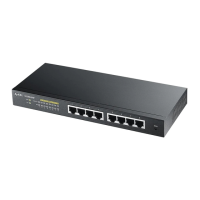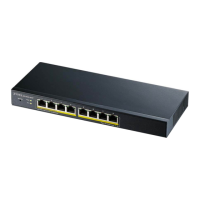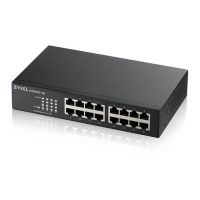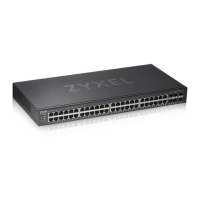Chapter 48 Port
GS1350 Series User’s Guide
339
Priority When the total power requested by the PDs exceeds the total PoE power budget on the Switch,
you can set the PD priority to allow the Switch to provide power to ports with higher priority.
Select Critical to give the highest PD priority on the port.
Select High to set the Switch to assign the remaining power to the port after all critical priority
ports are served.
Select Low to set the Switch to assign the remaining power to the port after all critical and high
priority ports are served.
Power-Up Set how the Switch provides power to a connected PD at power-up.
802.3af – the Switch follows the IEEE 802.3af Power over Ethernet standard to supply power to the
connected PDs during power-up.
Legacy – the Switch can provide power to the connected PDs that require high inrush currents at
power-up. Inrush current is the maximum, instantaneous input current drawn by the PD when first
turned on.
Pre-802.3at – the Switch initially offers power on the port according to the IEEE 802.3af standard,
and then switches to support the IEEE 802.3at standard within 75 milliseconds after a PD is
connected to the port. Select this option if the Switch is performing 2-event Layer-1 classification
(PoE+ hardware classification) or the connected PD is NOT performing Layer 2 power
classification using Link Layer Discovery Protocol (LLDP).
802.3at – the Switch supports the IEEE 802.3at High Power over Ethernet standard and can supply
power of up to 30 W per Ethernet port. IEEE 802.3at is also known as PoE+ or PoE Plus. An IEEE
802.3at compatible device is referred to as Type 2. Power Class 4 (High Power) can only be used
by Type 2 devices. If the connected PD requires a Class 4 current when it is turned on, it will be
powered up in this mode.
Force-802.3at – the Switch offers power of up to 33 W on the port without performing PoE
hardware classification. Select this option if the connected PD does not comply with any PoE
standard and requests power higher than a standard power limit.
Pre-802.3bt – the Switch offers power on the port according to the IEEE 802.3bt standard. Select
this option if the connected PD was developed before the IEEE 802.3bt standard is implemented
but requires power between 33 W and 60 W.
802.3bt – the Switch supports the IEEE 802.3bt standard and can supply power of up to 60 W per
Ethernet port to the connected PDs at power-up.
Max Power
(mW)
Specify the maximum amount of power the PD could use from the Switch on this port. If you leave
this field blank, the Switch refers to the standard or default maximum power for each class.
Note: The setting you enter here will NOT take effect when the power-up mode is set to
802.3bt.
Wide Range
Detection
Select this to let the Switch have a wider detection range for the PD.
The Switch detects whether a connected device is a powered device or not before supplying
power to the port. For the PD detection, the Switch applies a fixed voltage to the device and
then receives returned current. If the returned current is within the IEEE 802.3AF/AT standard
range, the device will be considered as a valid PD by the Switch.
However, in real cases, environmental interferences might easily cause the returned current to be
out of the standard range.
Table 169 Port > PoE Setup > PoE Setup (continued)
LABEL DESCRIPTION

